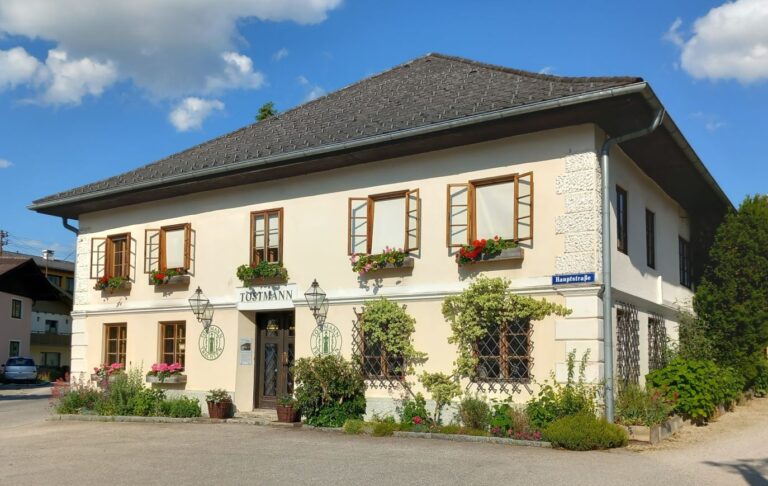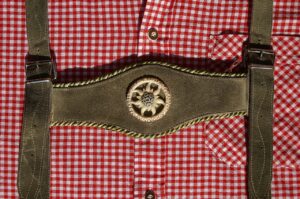After I divorced late last year and relocated to Austria, I joined a gym. I needed the routine, the contact with people, even if nothing beyond pleasantries was spoken. And I needed to invert the pear, which could be blamed on poor genes and the complacency of marriage.
It worked. I didn’t lose a lot of weight; I just moved it upstairs. Enough for me to drop a waist size. I went to try on my Lederhose in anticipation of Oktoberfest in September and discovered they were too big. Lederhosen are meant to be snug, form-fitting. Mine now hung from me like the shapeless goat hide that had been used to make them.
Lederhosen, which translates as leather breeches, are the traditional dress – the Tracht – of the Bavarian state of Germany, and of Austria. In Austria, men can be seen wearing them as part of their daily life. It may not be often and it is likely outside of the major cities, but it happens. More frequently, men wear lederhosen for weddings, for first communions, for various religious holidays and events, like the raising of the Maypole. When you see them worn for these festive occasions, you will probably be seeing them worn properly, with a white linen shirt, perhaps, appropriate leather shoes, and densely woven wool socks that rise to the knees. The Lederhosen themselves will likely be representative of whatever region you are in; the details like the buttons and embroidery share a common theme. These are men who wear the costume as their birthright. They take it seriously; they wear it proudly.
I do not wear Lederhose on these occasions. It is not my birthright. I am a citizen, but I was not born in Austria. I wear Lederhose only at Oktoberfest in Munich, the one occasion in my opinion where everyone gets a pass to wear them. It’s a sign of respect. And it demonstrates a modicum of self-awareness. For anyone but a Bavarian or Austrian to wear lederhosen outside of Oktoberfest would be like putting a New Yorker in a pair of cowboy boots and a Stetson.
I look at it this way.
When my family moved to Texas (I was fourteen at the time), Texas was like another country. It had its own history, a unique cuisine, its own holidays. Men wore cowboy boots and slim boot-cut jeans with embossed leather belts and big oval buckles. Their shirts had a distinctive trim to them and pearl-white buttons. Older men would sometimes be seen wearing bollo ties. Many wore billed caps; some had the confidence to wear a cowboy hat.
My immediate reaction was to balk. To an East-coast kid, this attire looked ridiculous. And even if I were to have any desire to wear any part of this outfit, I didn’t have the accent to match it. I was not yet able to use y’all in any context, although I had made rapid progress with the use of fixing to in just about every sentence. Still, I was not a born and bred Texan. I had no right to look like one. Having a powerful disdain for it all helped to put it out of my mind. At first. I spent enough time in Texas to eventually wear cowboy boots. But that was as far as I took it.
But all of this taught me something. It taught me to respect the origins and cultures of other people. I can’t say how it all came together, but I have the belief that these costumes, these representations of “tribal” culture and long tradition are important. They are as crucial as the language or dialect spoken by a group, the cuisine eaten, and the way their life is arranged. It is why houses look different and are built differently in different parts of the world. Traditional Austrian houses bridge human society and nature; they represent an affinity with the Alpine landscape, the mountains. To be Austrian is to be a specific specimen of the human species. And what they wear, like what they live in, not only conveys this, it glorifies it.
This applies to everyone in varying degrees from Aboriginals to Texans, whether you wear a sarong, or a sombrero, or very little at all.
Cowboys are as American as it gets. Few would think of what they wear as ridiculous. We celebrate it. Austrians and Bavarians should do the same.
However, not all Austrians wear it. Some despise it. The reasons may vary, but Lederhosen – Tracht, generally – seem to have been politicized in a way. At one extreme, there is a political group in Austria currently, which consists largely of men who make a point of wearing Lederhosen to every meeting. They are making a statement – weaponizing it in a way. But the disdain for Tracht existed before. There are many progressive Austrians who would never wear it. I could be wrong, but I believe this has to do with the meaning conveyed by traditional dress, what it says about the wearer. It’s a legacy issue. For an Austrian (and probably for a Bavarian), it implies you have conservative political views; that you are perhaps more rural in your perspective; that you are, from the viewpoint of urbanites, a peasant.
This is unfortunate. It undermines the essence of having a traditional costume. Not every country has one. If you stop to think of a single person as representative of the US, you’re first port of call will always be a cowboy. That’s all we’ve got, and, in reality, it represents only a small portion of the country. We might think of cowboys as traditional, conservative in their views, but we don’t labor the point. Cowboys are as American as it gets. Few would think what they wear is ridiculous. We celebrate it. Austrians and Bavarians should do the same.
I bought my new Lederhose at Tostmann in Seewalchen, a village on the shore of Attersee in the Salzkammergut. Tostmann is known to be authentic in the Trachten they offer. The converted farmhouse at the center of the village is refined, its many little windows decorated with curtains in a traditional green shade, the white pine floorboards rustic, the woodwork genteel. And at the center of it all is the traditional costume for women – the Dirndl.

This combination of long skirt and apron paired with a bodice and white blouse underneath deserves mention. They are handmade by Tostmann in Austria.
Just as Lederhosen provide a man with a sense of elegant confidence, as if he wore black-tie, the Dirndl gives women a similar sense of formal elegance, with a suggestion of coquettish beauty. There is something bewitching about a Dirndl, a gentle charm that evokes the feminine in nature even as it flirts with sentimentality. Getting it right is at least as important as getting Lederhosen right. When you get it wrong – witness the stands outside the Munich Main Station flogging gaudy Halloween-like costumes – and you begin to understand how the common perception of Trachten as being kitschy and best avoided came about. But it doesn’t have to be this way.
I suggest you get yourself into a pair of Lederhose (ladies seem much more open to trying out a Dirndl). If you do, here are a few suggestions.

Rent first. If you take the plunge as part of a visit to Oktoberfest, I recommend Lederhosenverleih. Stick with the ones that end just above the knee. These are more handsome than the three-quarter length version. And don’t try getting away with anything that isn’t leather, like velour or worse – they’re Lederhosen, after all. Avoid the suspenders and the red-gingham shirts. This is the Oktoberfest uniform for tourists. A white collarless shirt works best. If the weather is cool, add a vest, but the right one can be a sartorial minefield. Stick with a solid color as much as possible. If you wear the knee-high traditional wool socks, you’ll be fine. And, finally, wear leather brogues of some kind.
They don’t have to be Haferlschuhe (the laces are often offset to the outside) – suede Oxfords would do nicely. You can even get away with leather boots, Chelseas or Chukkas. But, whatever you do, for God’s sake, don’t wear sneakers.
Once you’re fully decked out and wandering the Oktoberfest grounds like a local, try telling me you don’t feel fantastic. Wear them with respect – with Gemütlichkeit – and enjoy the pass.
